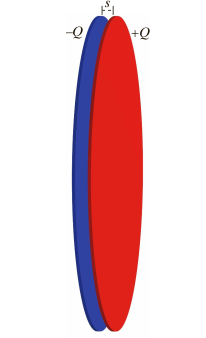Capacitor
Short Description of Topic
This page is all about the Electric Field due to a Point Charge.
Electric Field

Electric Field of two uniformly charged disks: A Capacitor
The Electric Field of a Capacitor can be found by the formula:
Electric field near the center of a two-plate capacitor
[math]\displaystyle{ \ E=\frac{Q/A}{\epsilon_0 } }[/math] One plate has charge [math]\displaystyle{ \ +Q }[/math] and other plate has charge [math]\displaystyle{ \ -Q }[/math]; each plate has area A; Direction is perpendicular to the plates. Assumption: separation between capacitor is very small compared to the area of a plate.
Fringe Field (just outside the plates near center of disk)
[math]\displaystyle{ \ E_{fringe}=\frac{Q/A}{2\epsilon_0 }(\frac{s}{R}) }[/math] [math]\displaystyle{ \ s }[/math] is the separation between plates; [math]\displaystyle{ \ R }[/math] is the radius of plate
The Algorithm
Step 1. Cut up the charge distribution into pieces and find the direction of [math]\displaystyle{ \Delta \vec{E} }[/math] at each location
Approximate electric field of a uniformly charged disk [math]\displaystyle{ \ E=\frac{Q/A}{2\epsilon_0 }[1-\frac{s}{R})] }[/math] or [math]\displaystyle{ \ E=\frac{Q/A}{2\epsilon_0 } }[/math]
At location 2, midpoint between two disks, both disks contribute electric field in the same direction. Therefore, [math]\displaystyle{ \vec{E}_{net} }[/math] is the largest at this location.
At location 1, because negative charged plate is closer, [math]\displaystyle{ \vec{E}_{net} }[/math] is to the right.
At location 3, because positive charged plate is closer, [math]\displaystyle{ \vec{E}_{net} }[/math] is to the left.
Examples
References
Matter and Interactions, 4th Edition